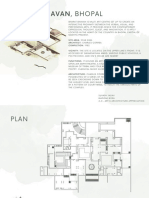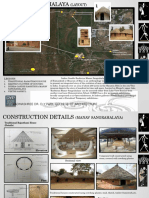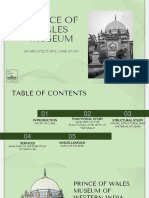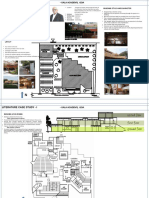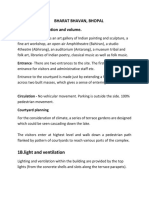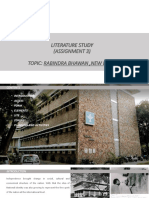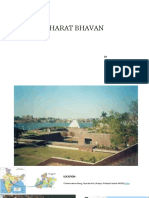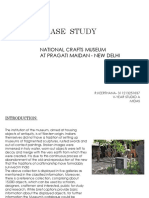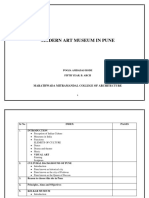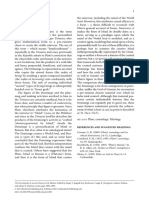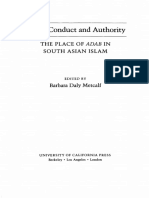Professional Documents
Culture Documents
Heritage Interpretation Centre Thesis Synopsis
Heritage Interpretation Centre Thesis Synopsis
Uploaded by
Pushkarani NOriginal Title
Copyright
Available Formats
Share this document
Did you find this document useful?
Is this content inappropriate?
Report this DocumentCopyright:
Available Formats
Heritage Interpretation Centre Thesis Synopsis
Heritage Interpretation Centre Thesis Synopsis
Uploaded by
Pushkarani NCopyright:
Available Formats
BGS SCHOOL OF ARCHITECTURE AND PLANNING
BGS International Residential School Campus, Nithyanandha Nagar, K. Gollahalli Post,
Bangalore South - 560074
TABLE OF CONTENTS
1. AIM ………………………………………………………………..……………………….………..3
2. INTRODUCTION…………………………………………………………………….……………..3
3. OBJECTIVE ……………………………………………………………………………………….3
4. SCOPE OF THE DESIGN ………………………………………………………………………...3
5. FOCUS ………………………………………………………………………………………………4
6. REQUIREMENTS…………………………………………………………………………………...4
7. CASE STUDIES …………………………………………………………………………………….5
8. RESEARCH …………………………………………………………………………………………6
18 ARC 8.3 Coursework – PUSHKARANI H N 1
BGS SCHOOL OF ARCHITECTURE AND PLANNING
BGS International Residential School Campus, Nithyanandha Nagar, K. Gollahalli Post,
Bangalore South - 560074
CULTURAL INTERPRETATION CENTRE
1. AIM
The aim of cultural interpretation center is to provide visitors with the experience that helps them to better
understand and appreciate the cultural heritage of a particular place. It can serve as a valuable tool for
promoting cultural awareness, understanding, and appreciation, and can help to foster greater respect and
tolerance for different cultures and ways of life.
2. INTRODUCTION
A interpretation centre or interpretive centre, is an institution for dissemination of knowledge of natural or
cultural heritage; these are located in connection to cultural, historic or natural sites.
Heritage is the best expression of cultural identity of the community of its civilization personally. Its one of
the aspects of the creativity that a community has in store, where it originates in individual or in groups.
Temples of varnasi, Ahmedabad, Ujjain, hampi, Jaipur and many more are considered to be the important
heritage cities in india.
3. SCOPE
• Interpretive center helps in preserving the rich cultural heritage of the place.
• Project will be combination of the art, architecture and the communal heritage.
• To promote cultural understanding and appreciation, provide educational opportunities, and foster
intercultural dialogue and exchange.
• cultural interpretation center have a broader focus, providing information and education on multiple
cultures, including local, regional, and international cultures.
• To offer exhibits, performances, lectures, workshops, and other programs that promote intercultural
understanding and dialogue.
• To showcase the traditions, art, history, and beliefs of that culture.
4. OBJECTIVES
• To preserve and promote the cultural heritage of a particular region or community.
• To interpret or spread knowledge on places such as historic buildings, artwork, and archaeological
sites, as well as cultural expressions like traditional music, dance, and storytelling.
• Cultural heritage centers typically serve as place for collections of cultural artifacts and provide
educational programming, exhibits, and research opportunities for the public.
• In addition to preserving and promoting cultural heritage, cultural heritage centers may also play a
role in tourism development by showcasing the unique cultural attractions of a particular region and
providing a space for visitors to learn about and engage with local culture.
18 ARC 8.3 Coursework – PUSHKARANI H N 2
BGS SCHOOL OF ARCHITECTURE AND PLANNING
BGS International Residential School Campus, Nithyanandha Nagar, K. Gollahalli Post,
Bangalore South - 560074
5. FOCUS OF CULTURAL INTERPRETATION CENTRES
• Exhibitions: Cultural interpretation centers create exhibitions to showcase the history and
traditions of their region. These exhibitions can be temporary or permanent and may include
displays, interactive exhibits, and educational programs.
• Education programs: Cultural interpretation centers offer educational programs for people of all
ages. These programs can include workshops, seminars, and classes on various topics related to
the cultural heritage of the region.
• Conservation and preservation: Cultural interpretation centers may also work on conservation
and preservation projects to protect historic sites and artifacts. This can involve activities such as
restoration, repair, and maintenance of cultural heritage assets.
• Digital resources: Many cultural interpretation centers are developing digital resources to
provide access to their collections and educational materials online. This can include virtual tours,
online exhibitions, and digital archives.
• Community engagement: Cultural interpretation centers often work to engage the local
community in their activities. This can involve partnerships with local schools, community groups,
and other organizations to promote cultural awareness and heritage tourism.
6. REQUIREMENTS
1. Museum
2. Theatre
3. Library
4. Art gallery
5. Studio
6. Workshop area
7. Guest house
8. Dorm
9. Amphitheatre
10. Cafeteria
11. Administrative spaces
12. Recreational spaces
AYODHYA
The period of the Ramayana was, perhaps the most glorious
period in the history of ancient India. For not only did this age
mark the composition of the holiest scriptures, the Vedas, and
other sacred literature that laid the foundation of Indian culture
and civilization, but the era was also exemplary in its rule of law
and truthfulness.
Lord Ram was the ‘Adarsh Purush’ of the Ramayana – an ideal
in every fact of human behavior. Apart from this Ayodhya had a
special place in Indian history as well. So from religious and
historical point of view Ayodhya also enjoys eminent place.
18 ARC 8.3 Coursework – PUSHKARANI H N 3
BGS SCHOOL OF ARCHITECTURE AND PLANNING
BGS International Residential School Campus, Nithyanandha Nagar, K. Gollahalli Post,
Bangalore South - 560074
7. CASE STUDIES
2. Jawahar kala kendra, jaipur
Jawahar Kala Kendra is built like a red fort with no windows on its facade. The design was prepared by
the noted architect Charles correa in 1986 and the building was ready in 1992. The plan is inspired by
the original city plan of Jaipur, consisting of nine squares with central square left open. The Jawahar
Kala Kendra adapts and applies concepts from ancient architectural principles called the vastu vidya.
Site area : 9.5 acres
Image source : wikipedia
1. Bharat bhavan, bhopal
Bharat Bhavan is an autonomous multi-arts complex and museum in Bhopal, india , established in
Madhya Pradesh .The architect of the Bharat Bhavan is charles correa. Opened in 1982, facing the upper
lake, it houses multiple art galleries, a graphic printing workshop, a ceramics workshop, an open-air
amphitheatre, a studio theatre, an auditorium, a museum of tribal & folk art, and libraries of Indian
poetry, classical music & folk music.
Site area : 2.5 acres
18 ARC 8.3 Coursework – PUSHKARANI H N 4
BGS SCHOOL OF ARCHITECTURE AND PLANNING
BGS International Residential School Campus, Nithyanandha Nagar, K. Gollahalli Post,
Bangalore South - 560074
3. Hampi interpretation centre
AHMEDABAD
India's first UNESCO World Heritage City,
Ahmedabad or Amdavad is steeped in history and
tradition. Offering a seamless blend of spectacular
architecture of centuries-old mosques and
contemporary avant-garde design, Gujarat's biggest
city is a bustling cosmopolitan hub.
Ahmedabad is divided into two parts, cut into
distinct sections by the Sabarmati river.
UJJAIN
“The town fallen from heaven to bring heaven to
earth”, was how the famous Sanskrit poet Kalidasa had
described the ancient city of Ujjain. Located at the
heart of Madhya Pradesh, this ancient city is a labyrinth
of bustling lanes that weave through temple clusters,
earning Ujjain the moniker, “the city of temples”.
One of the seven sacred sites of Hinduism, Ujjain is
located on the banks of the holy Kshipra (Shipra) river.
18 ARC 8.3 Coursework – PUSHKARANI H N 5
BGS SCHOOL OF ARCHITECTURE AND PLANNING
BGS International Residential School Campus, Nithyanandha Nagar, K. Gollahalli Post,
Bangalore South - 560074
PATNA
One of the oldest living cities in the world, Patna, the capital
of Bihar, stands on the banks of River Ganges, proudly cradling
in its heart the city's heritage, patriotism and culture. A
bustling city with old neighbourhoods, Patna's heritage spans
across two millennia. An epicentre for various religions, the
city was the stronghold of several dynasties, and thus boasts
a treasure trove of culture and traditions.
Patna retains its historic charm, and antiquity whispers at
every corner accentuated by a vibrant blend of a multitude of
cultures - Buddhist, Sufi, Jain, Sikh and Hindu.
GAYA
Suspended in time, Gaya, in Bihar, is poised along the banks
of the sacred Falgu river. It is a prominent Hindu pilgrim
city, where tourists can trace the footsteps of Lord Rama.
Gaya holds the famous Vishnupad Temple as its crowning
glory, with a number of other spiritual sites scattered
around the region. Most of these spiritual sites are rooted
deep in legends and in stories of the epic Ramayana.
It is popularly believed that Lord Rama offered 'pinda-daan'
(offerings made to ancestors for ensuring they have peace)
at the famous Ramshila Hill and thus many pilgrims come
from far to do the same.
18 ARC 8.3 Coursework – PUSHKARANI H N 6
You might also like
- Lesson 2Document41 pagesLesson 2DIANA MARIA AKEXANDRA JIMENEZ HERRERA0% (1)
- Exemplar Song of Hope 1Document2 pagesExemplar Song of Hope 1api-331716140100% (4)
- Bharat Bhavan PDFDocument6 pagesBharat Bhavan PDFSUVASH YADAV50% (2)
- Synopsis, Indraprastha Sanskriti Kala Kendra, Dwarka, DelhiDocument14 pagesSynopsis, Indraprastha Sanskriti Kala Kendra, Dwarka, DelhiCelcius KNoch keine Bewertungen
- Annexure - Ii Applicable For Mysore City and Its Surrounding VillagesDocument31 pagesAnnexure - Ii Applicable For Mysore City and Its Surrounding VillagesAkshatha Nanjundappa0% (1)
- Calico MuseumDocument20 pagesCalico MuseumNidhi ThakkarNoch keine Bewertungen
- Daily Lesson Plan in English 8 - 7-10Document2 pagesDaily Lesson Plan in English 8 - 7-10Cherry Caisip67% (6)
- Jane Bennett. Vibrant Matter: A Political Ecology of ThingsDocument2 pagesJane Bennett. Vibrant Matter: A Political Ecology of ThingsAaron Wu50% (2)
- Bharat BhavanDocument15 pagesBharat BhavanArchi. clubNoch keine Bewertungen
- Norbulingka InstituteDocument61 pagesNorbulingka InstituteRiddhi Aggarwal100% (3)
- M. P. Tour Final A3 ReportDocument5 pagesM. P. Tour Final A3 ReportGunjan Uttamchandani0% (1)
- Ethics Case - Skit Script and Topics For Class DiscussionDocument7 pagesEthics Case - Skit Script and Topics For Class DiscussionSarvesh NatekarNoch keine Bewertungen
- GodanDocument4 pagesGodanmukesh vikram100% (1)
- Chapter 3 MOVEMENTS THAT HELPED SHAPE MODERN EDUCATIONAL THOUGHTS AND IDEALSDocument15 pagesChapter 3 MOVEMENTS THAT HELPED SHAPE MODERN EDUCATIONAL THOUGHTS AND IDEALSMark Palon Ylanan81% (16)
- LESSON PLAN (Orff Method)Document2 pagesLESSON PLAN (Orff Method)Jenna Marie Tolosa50% (2)
- What The Good Language Learner Can Teach UsDocument12 pagesWhat The Good Language Learner Can Teach UszunnyngozNoch keine Bewertungen
- NEW Cultural Centre SynopsisDocument32 pagesNEW Cultural Centre Synopsistannu singhNoch keine Bewertungen
- Performing Arts Centre Bengaluru by Sandhya S SarwananDocument53 pagesPerforming Arts Centre Bengaluru by Sandhya S SarwananSharvari GanpuleNoch keine Bewertungen
- Jayprakash NarayanDocument4 pagesJayprakash NarayanRutuj Parakh100% (1)
- NEW Cultural Centre SynopsisDocument32 pagesNEW Cultural Centre SynopsisAkshat Sharma100% (1)
- Thesis TopicDocument6 pagesThesis TopicCUBE ProjectsNoch keine Bewertungen
- Option 1-Art and Craft Village Vijayawada Option 2-Heritage Interpretation Center, Hyderabad Option 3 - Children'S VillageDocument19 pagesOption 1-Art and Craft Village Vijayawada Option 2-Heritage Interpretation Center, Hyderabad Option 3 - Children'S VillageMohd AnasNoch keine Bewertungen
- Cultural Heritage Cum Interpretation CentreDocument9 pagesCultural Heritage Cum Interpretation CentreISHA SINGHNoch keine Bewertungen
- Interpretatio Center, Mahabalipuram: A Thesis ReportDocument41 pagesInterpretatio Center, Mahabalipuram: A Thesis Reportrahul sagar100% (1)
- Case Studies Bharat Bhavan Triveni Kala Sangam IIC PDFDocument2 pagesCase Studies Bharat Bhavan Triveni Kala Sangam IIC PDFAishwarya Misaki Animae100% (6)
- Bharat BhavanDocument14 pagesBharat BhavanNareegara NimeshNoch keine Bewertungen
- Cultural Heritage Cum Interpretation Centre, Varanasi: Detailed SynopsisDocument9 pagesCultural Heritage Cum Interpretation Centre, Varanasi: Detailed SynopsisTejaswini Barde100% (1)
- Ajanta Visitor Centre Project AurangabadDocument28 pagesAjanta Visitor Centre Project AurangabadSanjay Bhagwat100% (2)
- Bharat Bhawan TODDocument33 pagesBharat Bhawan TODSunidhi Verma100% (1)
- Virasat e Khalsa Anandpur SahibDocument5 pagesVirasat e Khalsa Anandpur SahibRutuj Parakh100% (4)
- Bharat Bhavan BhopalDocument25 pagesBharat Bhavan BhopalVaibhav Ananda KadamNoch keine Bewertungen
- 2a - Chatrapati Shivaji Maharaj Vastu SangrahalayaDocument40 pages2a - Chatrapati Shivaji Maharaj Vastu SangrahalayaAnish KabraNoch keine Bewertungen
- Crafts Village Pragati MaidanDocument18 pagesCrafts Village Pragati MaidanNimar Arora100% (1)
- Litrature Case Study Kala AcademyDocument7 pagesLitrature Case Study Kala AcademyAbdul SakurNoch keine Bewertungen
- Bharat BhavanDocument10 pagesBharat BhavanHiren PatelNoch keine Bewertungen
- Architectural Thesis Report On Swaminarayan Temple, Puri - Divyansh MishraDocument83 pagesArchitectural Thesis Report On Swaminarayan Temple, Puri - Divyansh MishraDivyansh Mishra100% (2)
- Delhi Haat 2Document1 pageDelhi Haat 2Jacob Warren100% (2)
- Urban Haat RequirementsDocument5 pagesUrban Haat RequirementsRevathy Nanda100% (2)
- Virasat-E-khalsa and Heritage ComplexDocument50 pagesVirasat-E-khalsa and Heritage ComplexKartik Parihar67% (3)
- Architecture Experience CentreDocument7 pagesArchitecture Experience CentreVenkatesh RYNoch keine Bewertungen
- Revitalisation of Fabric of Temple Towns: Ar - Dinesh Hipparkar DR - Shahid RehmatDocument17 pagesRevitalisation of Fabric of Temple Towns: Ar - Dinesh Hipparkar DR - Shahid RehmatVinayak KhareNoch keine Bewertungen
- Rabindra BhawanDocument17 pagesRabindra Bhawangaurika grover50% (2)
- Thesis Synopsis (Agra Heritage Museum)Document5 pagesThesis Synopsis (Agra Heritage Museum)aarthy67% (3)
- Muesum SynopsisDocument5 pagesMuesum SynopsisPALKI GHAINoch keine Bewertungen
- Bharat BhavanDocument21 pagesBharat BhavanEtee Agrawal0% (1)
- Bharat BhavanDocument19 pagesBharat BhavanPunniya100% (1)
- Chhatrapati Shivaji Maharaj Vastu SangrahalayaDocument6 pagesChhatrapati Shivaji Maharaj Vastu Sangrahalaya2GI18AT068Noch keine Bewertungen
- Case Study - LLDCDocument8 pagesCase Study - LLDCNikita Jadhav80% (5)
- JKKDocument16 pagesJKKSilvi Jhangra100% (4)
- A Case of Bellasis Road, MumbaiDocument24 pagesA Case of Bellasis Road, MumbaiPrakshi hudda100% (2)
- Sanskriti Kala KendraDocument1 pageSanskriti Kala KendraIlisha SK100% (1)
- Case Studt 1Document11 pagesCase Studt 1keerthi R100% (1)
- Literature Case Study I Kala Academy Goa AccessDocument8 pagesLiterature Case Study I Kala Academy Goa AccessBasavaprabhu PatilNoch keine Bewertungen
- Final Presentation PDFDocument15 pagesFinal Presentation PDFRutuj Parakh100% (1)
- Mumbai Case StudyDocument23 pagesMumbai Case StudyRohit Tangri100% (1)
- SynopsisDocument4 pagesSynopsisrutujaNoch keine Bewertungen
- JPNIC Case StudyDocument6 pagesJPNIC Case StudySalahuddin Shaikh100% (5)
- Bhopal Site Thesis Ref PDFDocument68 pagesBhopal Site Thesis Ref PDFsagrikakhandka100% (1)
- KOOTHAMBALAMDocument4 pagesKOOTHAMBALAMcl manishaNoch keine Bewertungen
- Houses of GOA: Case StudyDocument13 pagesHouses of GOA: Case StudyChandan GuptaNoch keine Bewertungen
- Dilli Hatt, Pitampura Case StudyDocument19 pagesDilli Hatt, Pitampura Case StudySaransh YadavNoch keine Bewertungen
- Cut Plan, Elevations and Sections: Section DDocument1 pageCut Plan, Elevations and Sections: Section DRNoch keine Bewertungen
- CASE STUDY-Savitri Bhavan, Auroville: Location Savitri Bhavan, A Centre For Spiritual EducationDocument1 pageCASE STUDY-Savitri Bhavan, Auroville: Location Savitri Bhavan, A Centre For Spiritual EducationSagar Gheewala0% (1)
- Kala Mandira CASE STUDYDocument12 pagesKala Mandira CASE STUDYShívã Dúrgèsh SDNoch keine Bewertungen
- Case Study Bharat BhavanDocument5 pagesCase Study Bharat Bhavansuhail57% (7)
- Thesis SynopsisDocument5 pagesThesis SynopsisPushkarani NNoch keine Bewertungen
- Cultural and Heritage Center Kerala by Gowri HariDocument63 pagesCultural and Heritage Center Kerala by Gowri HariAbijith Ashraf100% (1)
- Synopsis 03.1Document6 pagesSynopsis 03.1Prashant NehraNoch keine Bewertungen
- Black Book MuseumDocument63 pagesBlack Book Museumpooja rodeNoch keine Bewertungen
- UT Dallas Syllabus For Ed3342.501.08s Taught by Teresa Parker (Tparker)Document8 pagesUT Dallas Syllabus For Ed3342.501.08s Taught by Teresa Parker (Tparker)UT Dallas Provost's Technology GroupNoch keine Bewertungen
- Evalinda Ramos: ObjectiveDocument3 pagesEvalinda Ramos: ObjectiveGreenNoch keine Bewertungen
- Tkam Chapter 4Document5 pagesTkam Chapter 4api-300759812Noch keine Bewertungen
- The Deccan School of Miniature Painting: Origin and DevelopmentDocument1 pageThe Deccan School of Miniature Painting: Origin and DevelopmentRudra Pratap SinghNoch keine Bewertungen
- Demiurge PDFDocument1 pageDemiurge PDFPricopi VictorNoch keine Bewertungen
- Australian Aboriginal SongsDocument5 pagesAustralian Aboriginal SongsJonathan Spinks100% (1)
- Summative Test in UCSPDocument3 pagesSummative Test in UCSPQuarentai Siete LptNoch keine Bewertungen
- Melvin Manzo Module 1: You, The Teacher, As A Person in Society: Your Philosophical HeritageDocument44 pagesMelvin Manzo Module 1: You, The Teacher, As A Person in Society: Your Philosophical HeritageMaela Pollen Elumba Yema100% (1)
- z2008 2588 PDFDocument3 pagesz2008 2588 PDFAmàr AqmarNoch keine Bewertungen
- Regional Demo Lesson PlanDocument5 pagesRegional Demo Lesson PlanLeu Gim Habana PanuganNoch keine Bewertungen
- 1.priya r3 The Mango SeasonDocument24 pages1.priya r3 The Mango SeasonVinoshni NairNoch keine Bewertungen
- NEW C.V. BHAVESH SonkusareDocument2 pagesNEW C.V. BHAVESH SonkusareGaurav SonkeshariyaNoch keine Bewertungen
- History of The Church 1Document29 pagesHistory of The Church 1Chandria SimbulanNoch keine Bewertungen
- Interview Questions For DiversityDocument4 pagesInterview Questions For Diversitykrystel3sNoch keine Bewertungen
- Understanding English Grammar: A Linguistic Introduction: 1. Nasal AssimilationDocument5 pagesUnderstanding English Grammar: A Linguistic Introduction: 1. Nasal AssimilationEvelyn Díaz IturriagaNoch keine Bewertungen
- Horikoshi High School Introduction Hey All... Well...Document6 pagesHorikoshi High School Introduction Hey All... Well...geronsky06Noch keine Bewertungen
- James Lentini Interview in Fanfare Magazine, April, 2020Document9 pagesJames Lentini Interview in Fanfare Magazine, April, 2020James LentiniNoch keine Bewertungen
- Ums Shoebox Speech AssignmentDocument5 pagesUms Shoebox Speech Assignmentapi-421340277Noch keine Bewertungen
- NF en 12973Document65 pagesNF en 12973ZmanNoch keine Bewertungen
- 1 PBDocument7 pages1 PBSattigul KharakozhaNoch keine Bewertungen
- Cse-Sar 2018Document150 pagesCse-Sar 2018Ksrinivas RaoNoch keine Bewertungen


